THE BLAYDON RACES
The races legend is a matter of great pride to Blaydon folk.
The song lyrics, written by Geordie Ridley, tell of the five mile journey from Newcastle west to Blaydon on race day, 9th June 1862, and of the characters and incidents along the way. The words were said to be written to fit a pre-existing melody 'Brighton'. There is a Victorian tune 'All on the road to Brighton' by Redwood & Pelissier which has a similar type of story line, so may have given Ridley the basic idea, but the melody is not the same so this remains a puzzle. Perhaps Ridley got the storyline idea from this song and gave it a similar jaunty, rolling 6/8 metre but the melody is otherwise quite different.
The history of the actual race meetings is a fascinating and checkered one. The first was held in 1811. It all started as a 'point to point' on land where Blaydon railway station is now situated. The local keelmen (and there were many) used to do their sword dance at local villages and the money raised was used for the race prizes. The Hoppings, a travelling village fun fair, visited Blaydon Haughs (The Spike) at the same time time, so it was all quite a big social event. Sadly the building of the railway station brought these meetings to an end, the last being in 1835.
In 1859 plans to revive them at a new site came to fruition and after a successful trial period the first official meeting was held in 1861. It was now in the British Racing Calendar. The circular track, of about one mile circumference, was on Blaydon Island (also known as Dent's Meadow). See map - small arrow points to the island.This was a large island in the River Tyne, situated between Blaydon, on the south bank, and Newburn Haugh, on the north bank. Most of the racegoers travelled over to the island on small ferry boats or keel boats, from the Blaydon side. Access onto the island from the north, over the expansive, boggy Newburn Haugh may have been difficult for the general public although the horses were brought from the north bank after being stabled at Lemington. The 1861 meeting ended with an evening dance at the Mechanic's Hall in Blaydon. The great success of the event resulted in a repeat the following year, on 9th June 1862, when the arrangements were similar. Music Hall artist Geordie Ridley performed his new song, The Blaydon Races, at Blaydon Mechanic's Hall that same evening. The first performance had been at Balmbra's Music Hall in Newcastle just a few days earlier when it was used to exhort people to attend. The meetings then continued on annually until 1865 but by then Geordie Ridley had gone. Tragically he passed away in 1864, aged only 29. He had never recovered from the serious pit accident he suffered as a young man.
Blaydon Island ceased to exist after improvements to the river by The Tyne Improvement Commission. The TIC was created in 1850 to improve the navigability of the river which had been badly neglected. It set about improving river depth by dredging, smoothing out some bends in the river and removing some river islands. There were a few islands between Dunston and Blaydon, one being Dent's Meadow or Blaydon Island, the earlier site of the races, also King's Meadows opposite Elswick, Clarence (Annie), and George (Little Annie). River dredging completely removed these. The work carried out by the TIC, together with the rapid growth of the railway network, sadly signalled the end for the local keelmen.
Finally the races were revived once more in 1887 and held on a track a little further west, on Stella Haughs. Initially they thrived but by the late 1890's they were in decline. Despite this, they continued up to 1916 when civil disorder, caused by a dubious race result, caused the authorities to close down the meeting. There were concerns about misbehaviour and security, it being war time. The song meanwhile had been fervently adopted as an anthem, sung by all at public gatherings, football matches, etc. It was of such universal appeal that to this day it remains synonymous with Tyneside and the Geordies, and is known throughout the world.
A big celebration of the races took place at the centenary, 9th June 1962, with a huge parade starting at Balmbras and ending at Blaydon. It included decorated floats, vintage vehicles and so on, also lots of ancillary events. Thousands of folk turned out to see it. A similar event was organised by an enthusiastic committee on 9th June 2012, to celebrate 150 years. For many years now there has also been a five mile road race over the route, which attracts top athletes as well as enthusiastic joggers. It too is very well supported. So in these activities, as well as the continued popularity of the anthem, the Blaydon Races legend lives on.
Blaydon Island, the site of the races at the time of Geordie Ridley's song, is no more. The remnants form part of the expansive flat, damp meadow, known as Newburn Haugh, on the north bank of the Tyne. The two maps below, one drawn in 1871 and the other an update in 1881, show the island then the dredged, modified river with the island gone. Also you can see where the 'S' bend at Blaydon Haughs (The Spike) was removed. These two images are shown by permission of the Librarian, Robinson Library, Newcastle University. I wish to thank them for making them available. They must not be copied or reproduced without their permission.
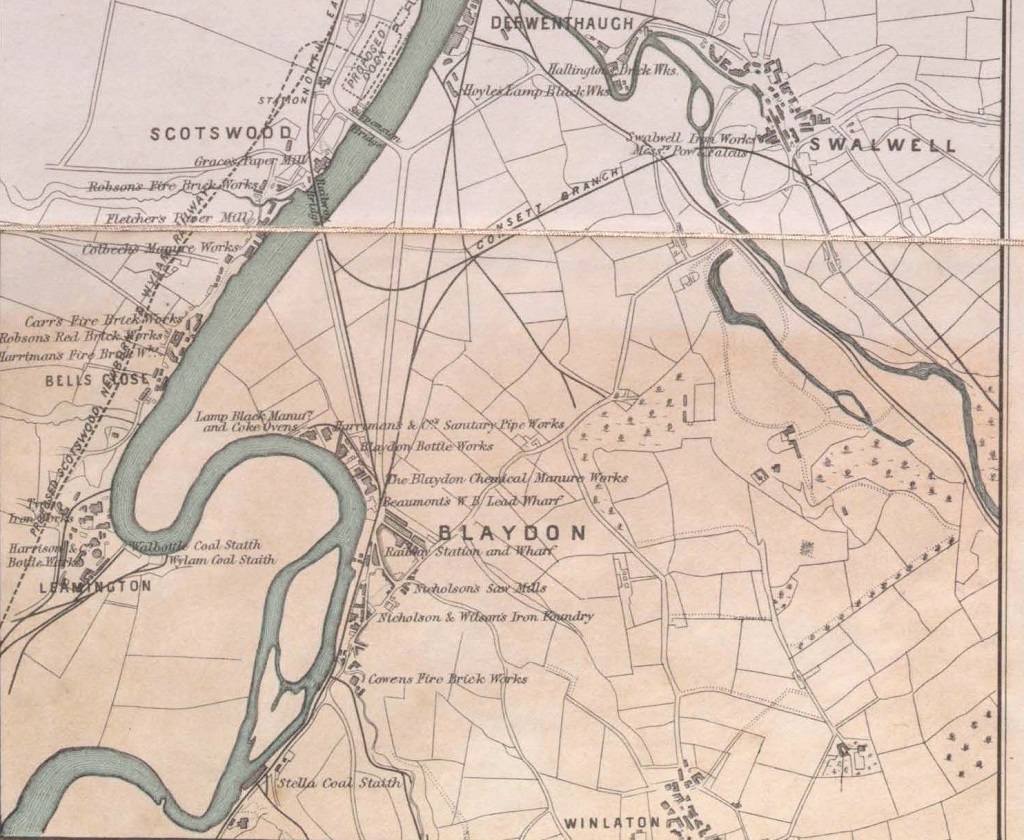
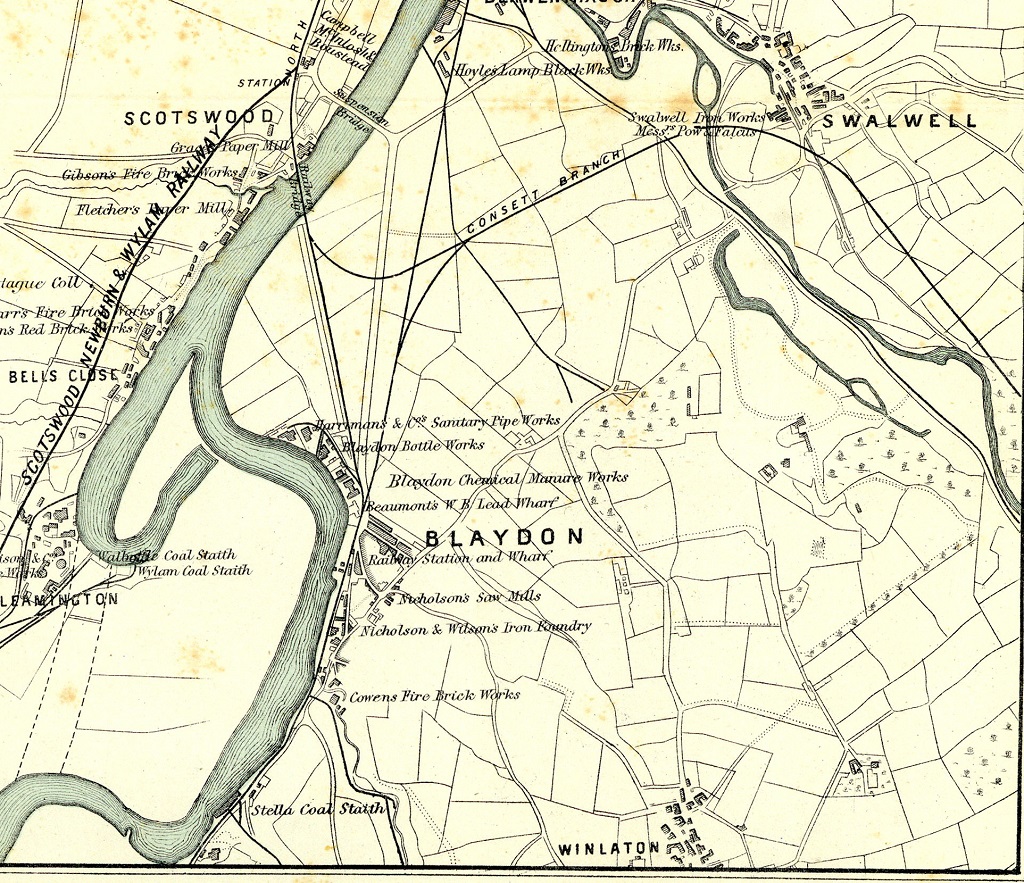
Below are some of my own photos (taken Oct 2011) from the vicinity of where Blaydon Island was situated, looking south over to Blaydon and The Spike, north across Newburn Haugh and of an old ferry landing on the south bank.
Top left - From near what used to be Blaydon Island, looking south to Blaydon and on the far left Blaydon Haughs.
Top right - looking north west across the flat damp meadows of Newburn Haugh.
Second left - from north bank looking down river to the A1 bridge.
Second right - from near what was Blaydon Island, looking south to Blaydon - Saint Cuthbert's Church visible.
Third left - looking north across Newburn Haugh to Lemington - Lemington Glass Works preserved cone visible.
Third right - telephoto pic of the old Lemington Glass Works. My Great Uncle Tommy (Thomas Reay) was a foreman engineer there.
Fouth left - from near what was Blaydon Island, looking south east to Blaydon Haughs (The Spike).
Fouth right - from east of what used to be Blaydon Island, looking across to The Spike on the south bank, A1 bridge in the distance.
Bottom left - ferry landing for the Blaydon Ferry? It lies between the railway station and western end of The Spike. It's location is consistent with old nineteenth century maps.
Bottom right - wreck of an old boat (was this the ferry boat?) visible at low tide.
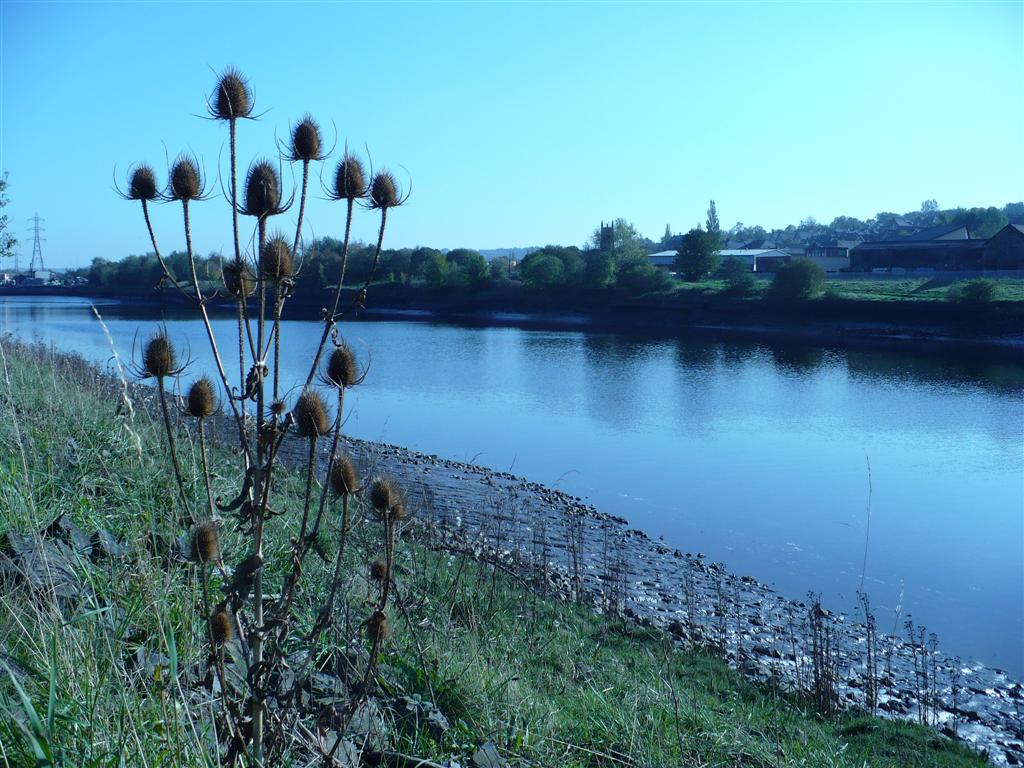
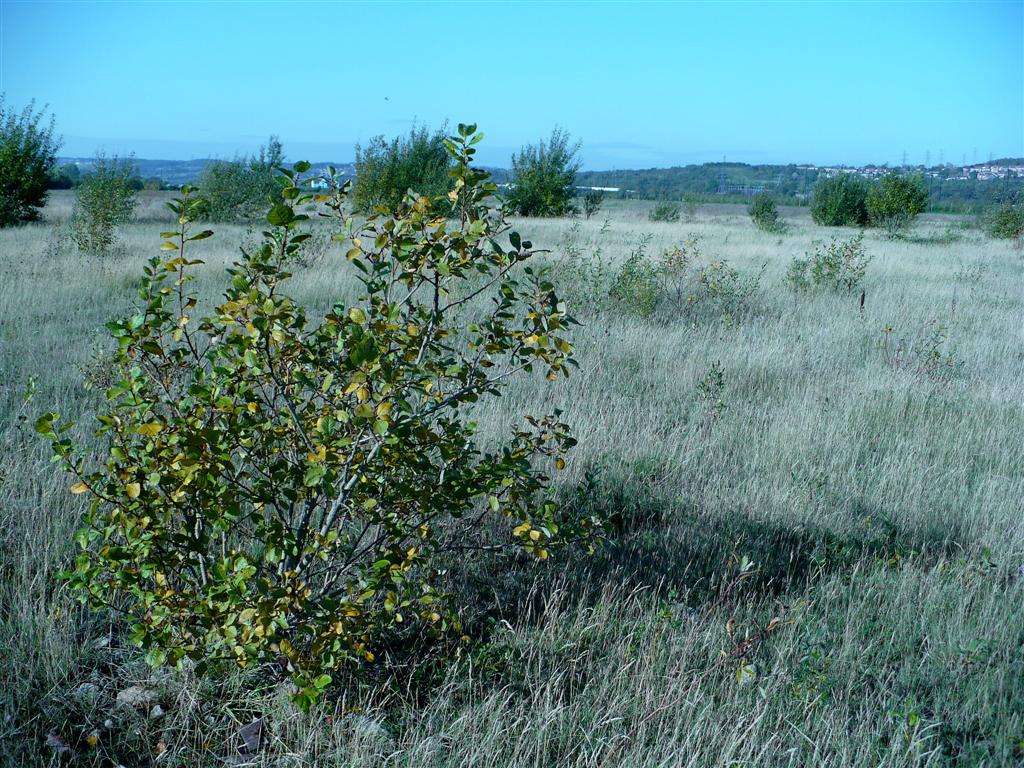
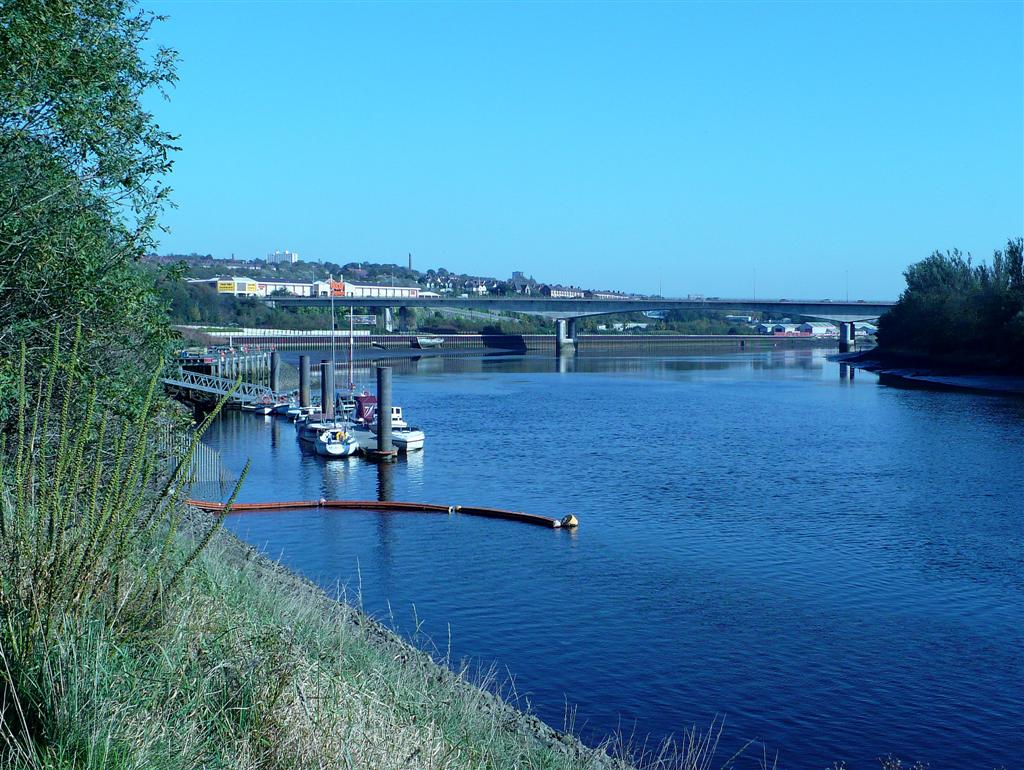
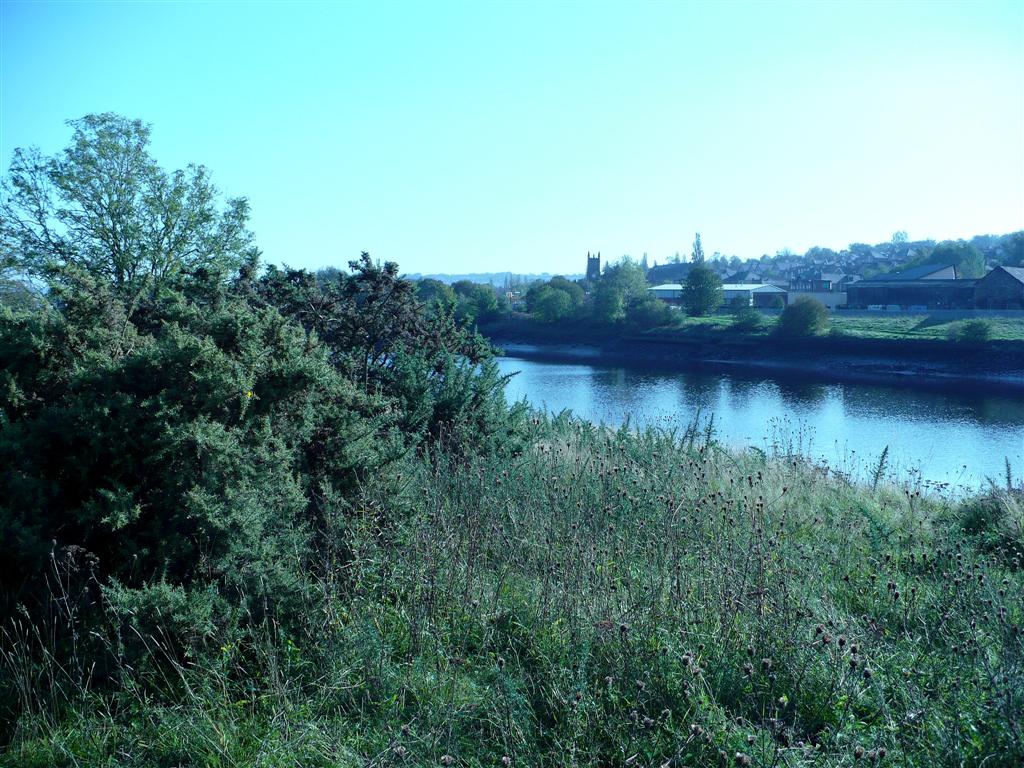
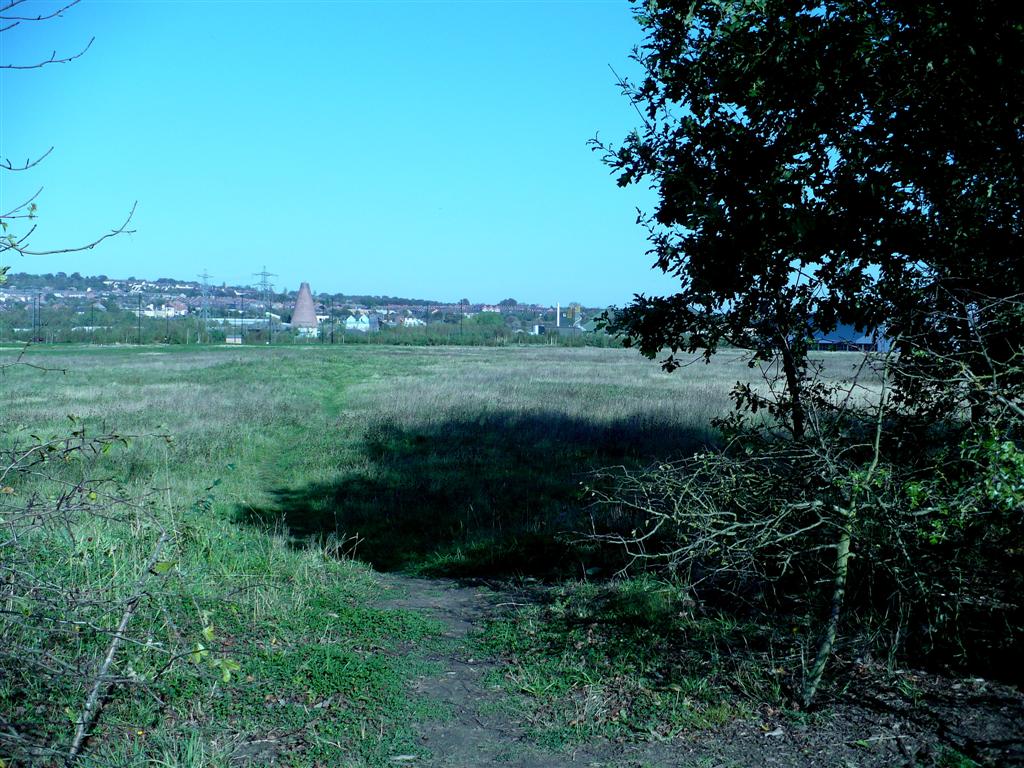
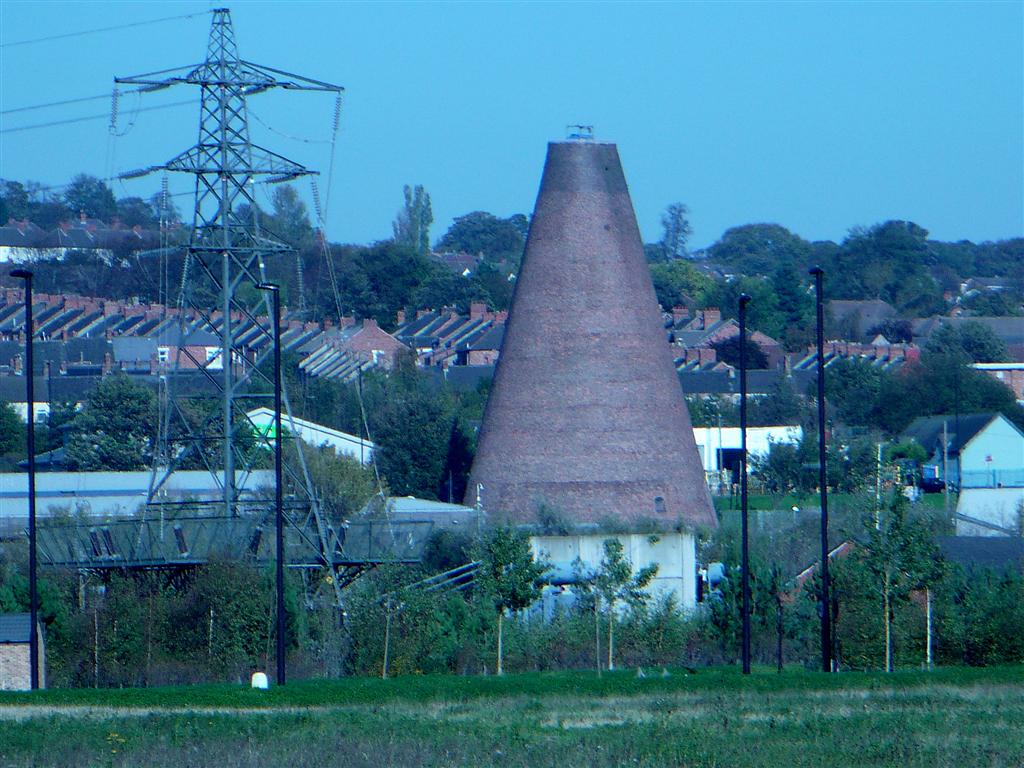
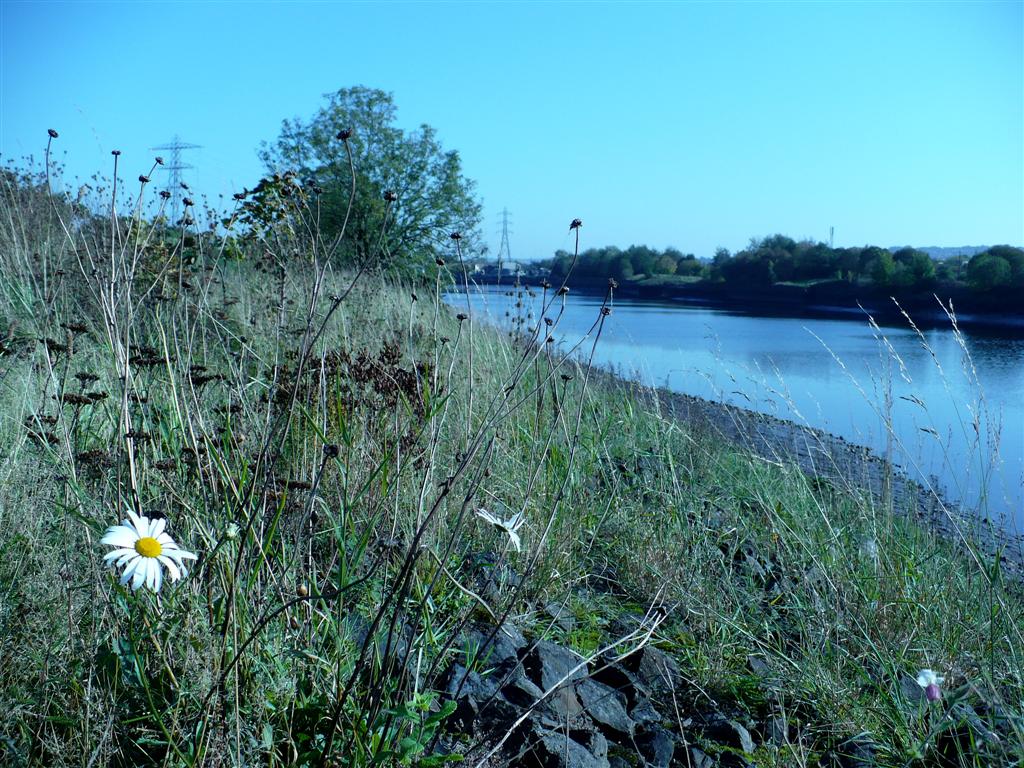
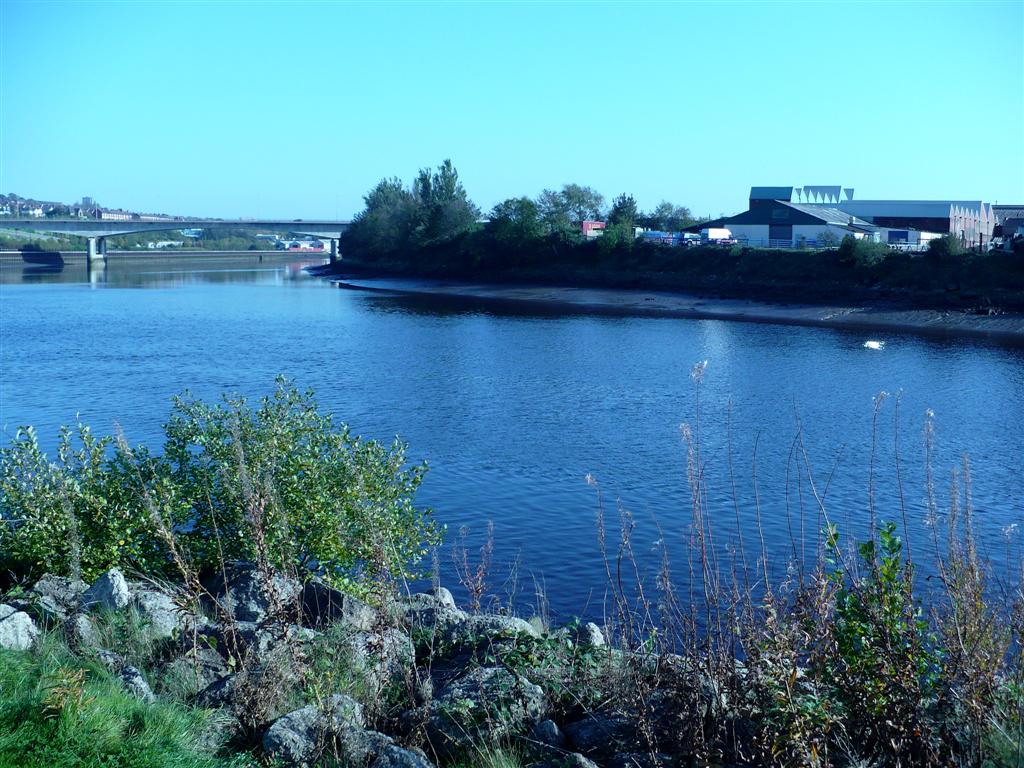
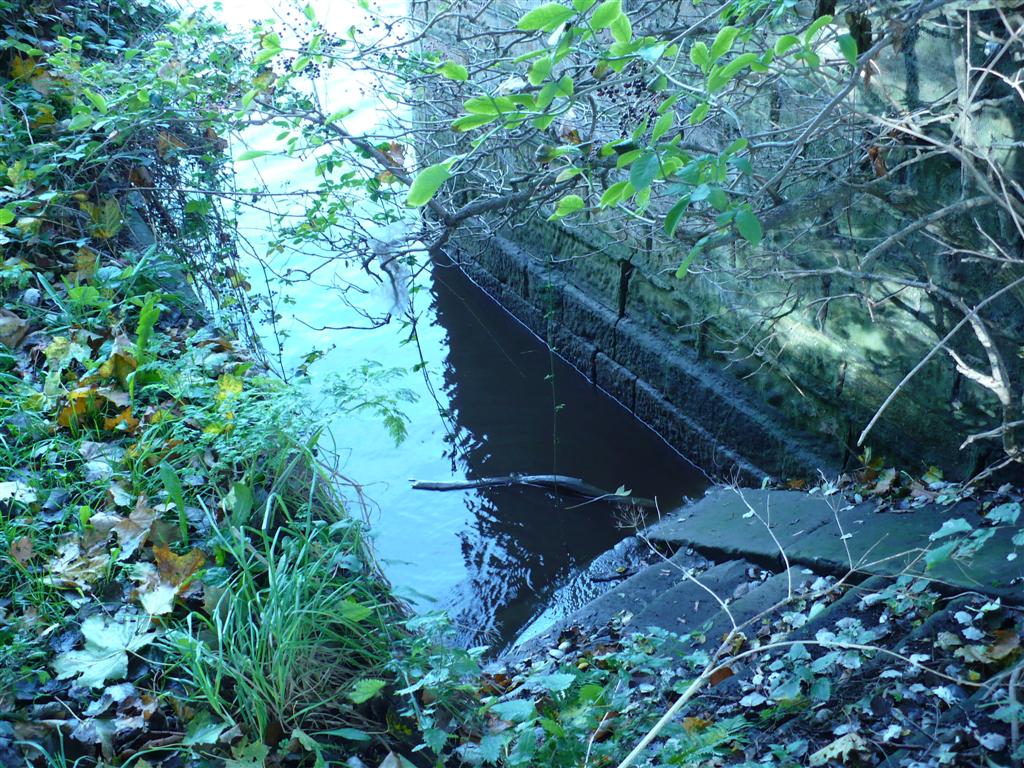
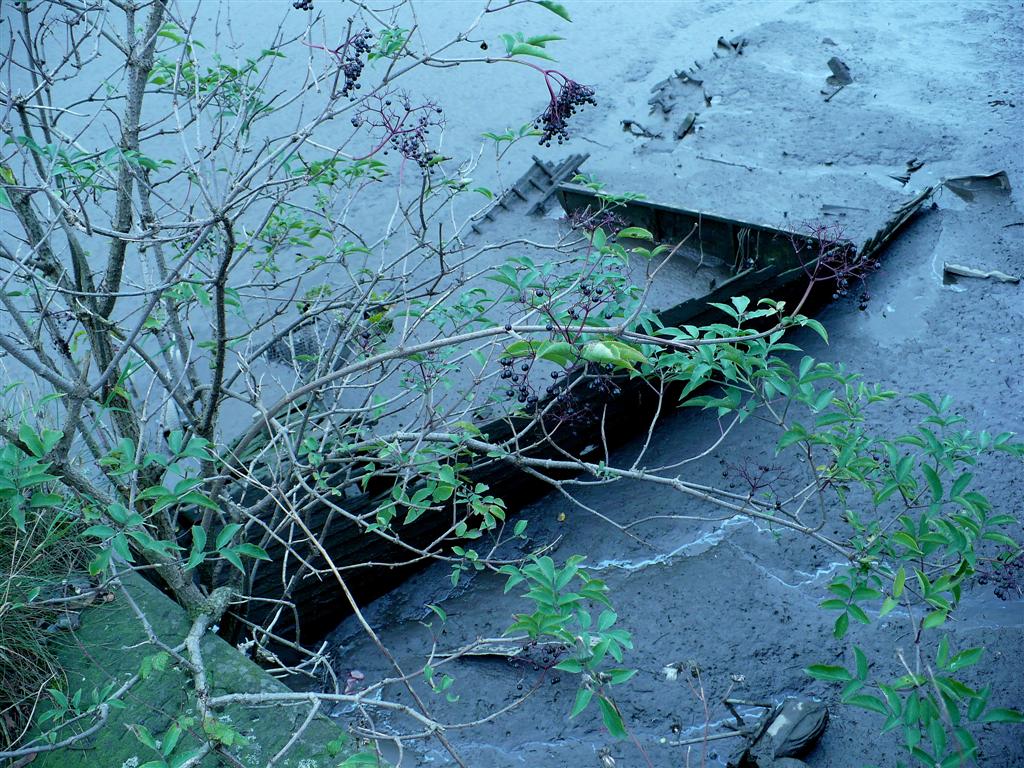
BLAYDON RACES LYRICS
Aa went te Blaydon Races, t’was on the ninth of June
Eighteen hundred and sixty two, on a summer’s afternoon
Aa took a bus from Balmbra’s and she was heavy laden
Away went along Collingwood Street that’s on the road to Blaydon
Chorus - - -
Oh lads – you should a seen us gannin
Passin’ the folks upon the road just as they were stannin’
Thor was lots a lads and lasses there, aal wi smilin’ faces
Gannin alang the Scotswood Road, te see the Blaydon Races
We flew past Armstrongs factory, reet up te the Robin Adair
Just gannin’ doon te the railway bridge, the bus wheel flew off there
The lasses lost thor crinolines and the veils that hid thor faces
Aa got two black eyes and a broken nose in gannin’ te Blaydon Races
Noo when we got the wheel put on away we went again
But them that had their noses broke, they came back ower hyem
Some went te the dispensary and some to Doctor Gibbs’s
And some to the infirmary to mend their broken ribs’s
Noo when we got to Paradise there was bonny game begun
There was four and twenty on the bus, man how they danced and sung
They called on me to sing a song, I sung them Paddy Fagan
Aa danced a jig an swung me twig, that day I went to Blaydon
We flew across the Chain Bridge, reet into Blaydon Town
The bellman he was caallin’ there, they called him Jackie Broon
Aa saw him talkin’ to some cheps and them he was persuadin’
Te gan and see Geordie Ridley’s show in The Mechanics Hall at Blaydon
The rain it poured doon aal day and made the ground quite muddy
Coffee Johnny had a white hat on – they yelled ‘we (who) stole the cuddy?’
Thor was spice stalls and monkey shows and aad wives sellin’ ciders
And a chap with a ha’penny roondaboot shootin’ ‘Noo me lads for riders’.
EXPLANATION OF LYRICS
BALMBRA'S - On 5th June 1862 Geordie Ridley performed his song 'The Blaydon Races' for the first time at the Wheatsheaf Inn, run by John Balmbra on the Cloth Market in Newcastle.
Balmbra's Music Hall was built and opened in 1848 as a room in the Wheatsheaf pub. It was renamed the Royal Music Hall 1859. And again renamed, this time to the Wheatsheaf Music Hall in 1864. It was once again renamed in 1865 this time to the Oxford Music Hall.
The original building was demolished after a fire in 1899 and a new building built in its place in 1901. This new building was subsequently converted into a Music Hall recreation called Balmbra's in 1962
Due to the fire in 1899 nothing now remains of the original Balmbra's Music Hall building.
ARMSTRONG'S FACTORY - W.G. Armstrong first established his armaments works in Elswick in 1847. It eventually became famous as Vickers Armstrongs. By the time Ridley wrote the song fifteen years later the success of Armstrong's factory was transforming the area as a rapidly expanding workforce were housed in terraces north of Scotswood Road.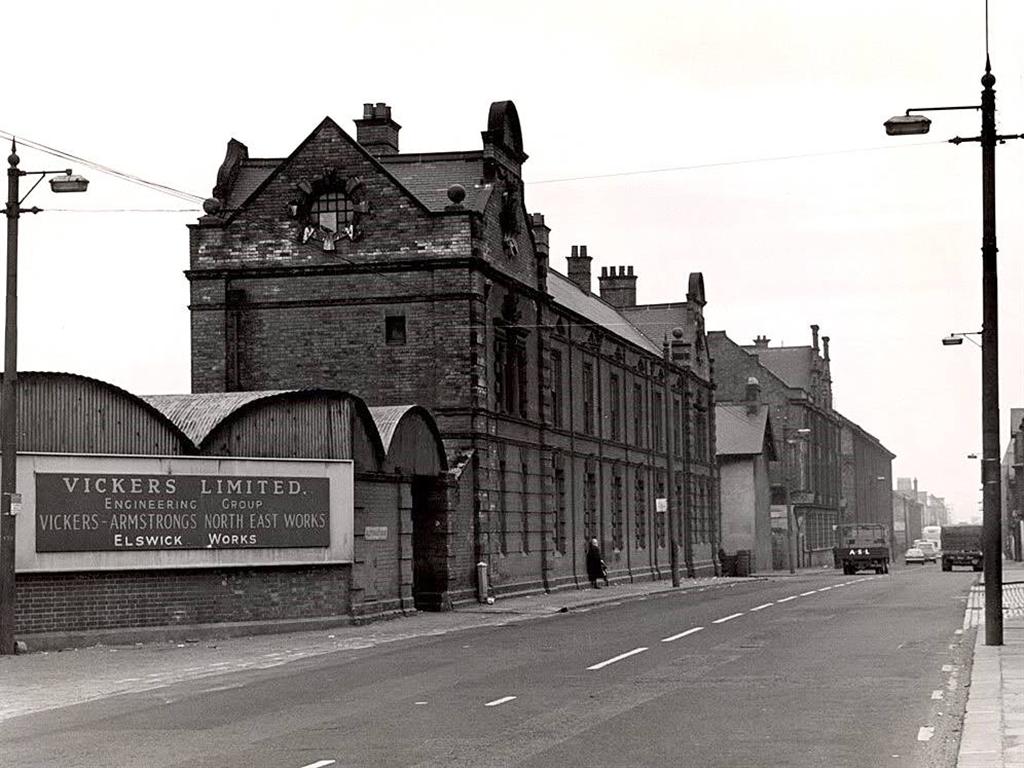
At it's peak the factory was reputed to be the biggest in the world, with engineering shops running from Newcastle's west end along to Scotswood, a distance of four miles. One of the jokes engineers played on new apprentices was to send them on an errand to seek some item at Shop XX - unknown to the apprentice it would be at the far end so he might have to walk many miles to get there and back only to discover the prank.
THE ROBIN ADAIR - By the end of the century the population of Elswick had risen from 1800 to 60,000 and Scotswood Road flourished, becoming famous for its 44 pubs - one on every street corner - one such being the Robin Adair. Virtually all of the pubs and the terraced housing were demolished during the 1960s.
DOCTOR GIBB - Dr.Gibb (1824-1916) was originally 'house surgeon' at the Old Infirmary from 1849 to 1854, later setting up private practice on Westgate Road. A fair minded man who's consultation fee for rich and poor alike was 2/6d making him a popular figure among the community.
PARADISE - Paradise is just a small part of South Benwell, comprising the north shore of the river Tyne just west of the Armstrong Elswick Works, running up to Paradise Street and Evelyn Gardens, and the bottom half of Atkinson Road. About half way down Atkinson Road was the Paradise Church. It is more or less the mid point between Elswick and Scotswood, travelling west between Newcastle and Blaydon.
PADDY FAGAN - probably an old, long forgotten Irish song which was part of Geordie Ridley's repertoire. At this time (mid 1800s onwards) due to the potato famine and poverty in Ireland and a huge expansion in jobs in England/Scotland, due to the industrial revolution, there was substantial immigration of Irish workers to industrial hot beds such as Tyneside.
CHAIN BRIDGE - this was the old suspension bridge over the Tyne linking Scotswood with Blaydon. Once over the bridge onto the south side its about one mile, along Chain Bridge Road, into Blaydon town centre. The bridge was completed in 1831 to link the Hexham/Gateshead Turnpike (toll) road with the north bank of the Tyne. It was a toll bridge at first and the toll revenue successfully paid for its construction. As traffic volumes increased it became unable to cope and was demolished 1967 having been replaced by a wider bow shaped box girder bridge, just to the west. It was probably the most attractive of all the Tyneside bridges.
THE MECHANICS HALL - This was one of the many trade clubs (a form of workers social club) which sprang up during Victorian times. Members would relax with a drink, darts, dominoes, billiards, etc. and enjoy the conversation and camaraderie of their workmates. Blaydon Mechanics Hall was situated on Tyne Street - just over the road from the railway station. Sadly it was demolished during the late 1960s when all of this part of the town was subject to compulsory purchase orders, demolition and redevelopment.
COFFEE JOHNNY - aka Coffy Johnny and John Oliver (1829 – 7 April 1900) . He was a blacksmith in the village of Winlaton, a trumpeter in the Winlaton Brass Band, a bare fist boxer and Geordie celebrity. He was well known for his tall height and for wearing a white top hat. This can be seen in photographs and in William Irving's painting 'Blaydon Races' which is above (he's on the right of the painting). His grave is in Winlaton Cemetary off West Lane and has a special commemorative headstone arranged some years ago by Winlaton History Society.
On the 9th June 1962 a large scale celebration of the centenary took place. A huge parade/cavalcade, sports events, social activities, fairs and more. It was quite an occasion and a wonderful celebration of the Races legend. A further celebration along similar lines was organised at 150 years, 9th June 2012. The photograph below was taken in 1962 by my late father-in-law Jack Teasdale. Also each year on 9th June, The Blaydon Race (a road race for athletes) takes place along the five mile route west from Newcastle to Blaydon.
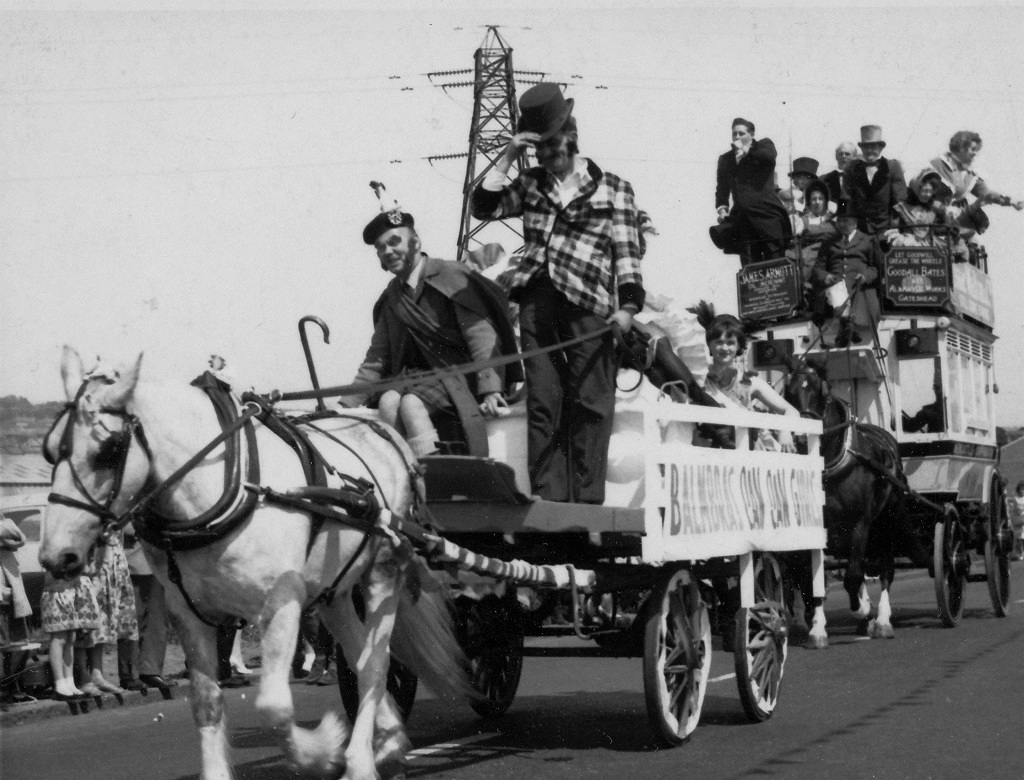
My thanks to Saint for sending me a copy of the flyer for the actual 1914 race meeting (see image below).
Copy of original held in Discovery Museum - "By kind donation from Councillor Mr. Thomas Charlton, Bleach Green, Winlaton."
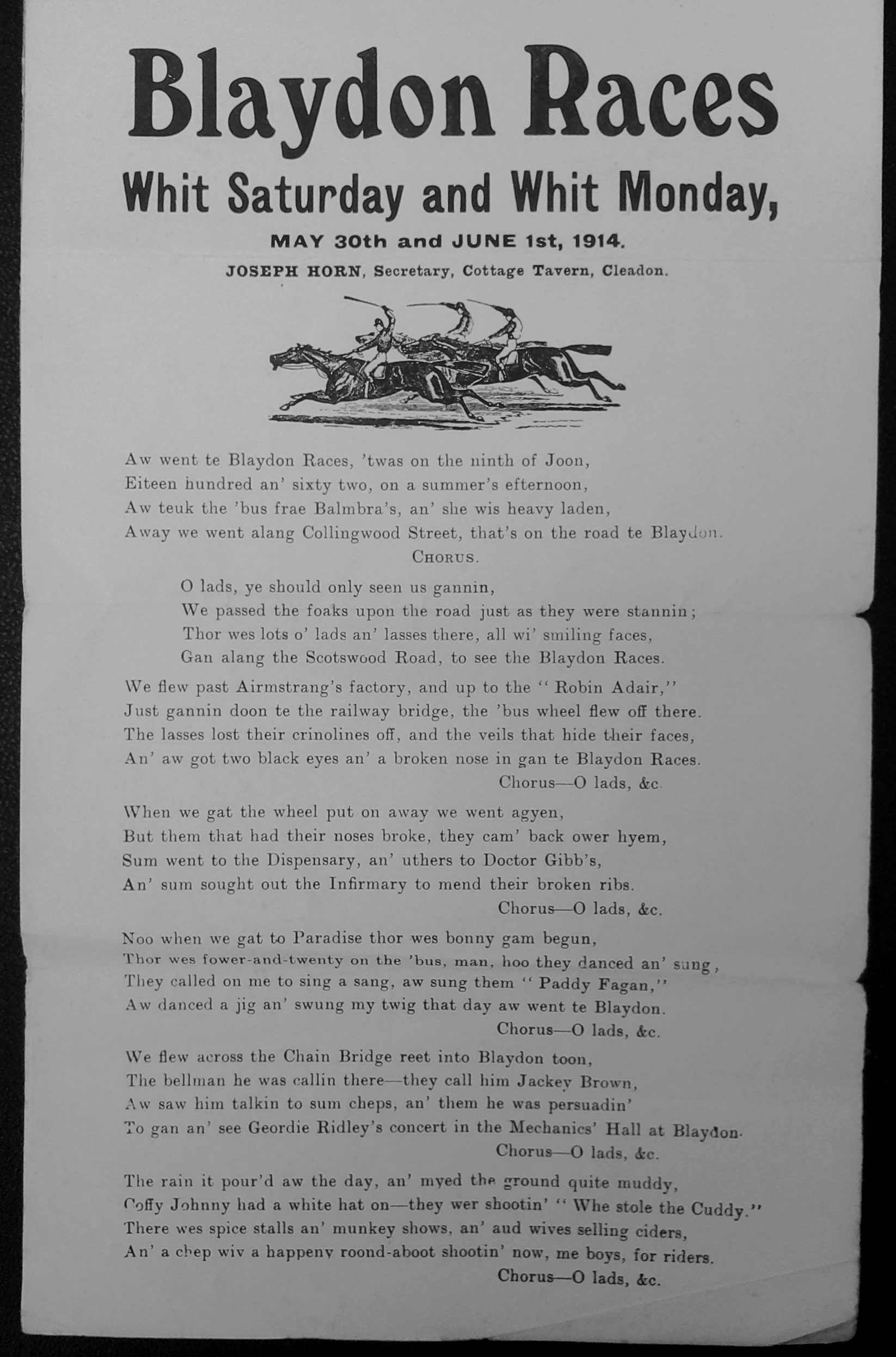
Roly Veitch
Updated 30th June 2024
For more information on our local area history, our unique dialect, our wealth of dialect songs and other topics please visit the home page menu - link below.
Back to Home Page